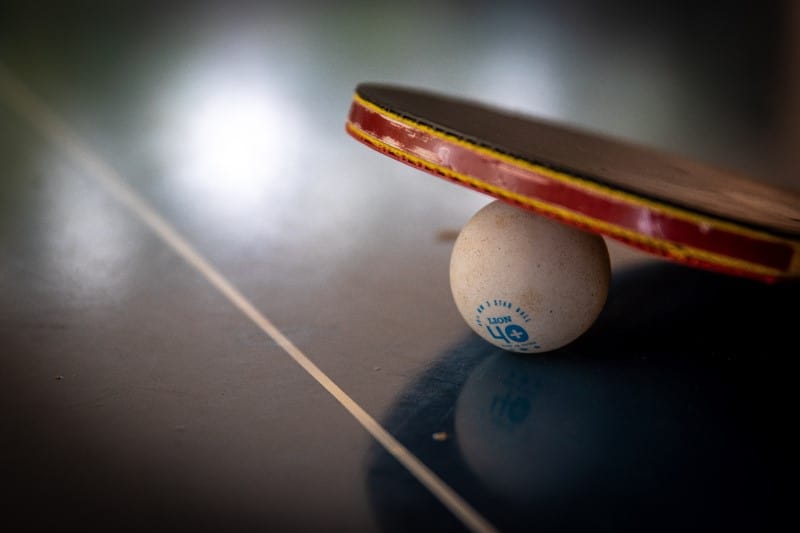If you are here, you are probably doing some kind of research about the differences between tennis and ping pong. If that is so, you have come to the right place.
I have been asked similar questions multiple times by people that wanted to get into sports. Both tennis and ping pong are amazing sports, but what exactly makes them different?
In (court) tennis, the playing field, balls, and racquet are larger. Tennis is more physically demanding, and games can last longer. In comparison, ping pong is very different from tennis. Ping pong is played on a table with smaller balls and paddles. Ping pong and tennis also have different rules.
Although both sports follow similar principles, they are fundamentally different.
Continue reading if you are interested in learning more intricate details about both ping pong and tennis. At the end of this article, you will have a better idea of how different and how similar they are.

Tennis vs. Ping Pong: What Are the Differences?
History
It is hard to pinpoint when exactly tennis was invented. Some people suggest that tennis traces its roots back to the 11th century when French monks played a game that resembled tennis.
Around the 1500s to 1800s, the game those French monks played “evolved”, so to speak. Wooden racquets, which had gut strings on them and balls made out of leather and cork, were introduced. However, this game was still very different from what we consider tennis today.
In 1873 Major Walter Wingfield invented what can be considered the true predecessor of today’s tennis.
Ping pong, on the other hand, had a more humble beginning. It is believed that it was first invented in the 1880s when tennis players were looking for ways to continue playing indoors.
What this also means is that it is very likely that ping pong is based on tennis.
Ping pong is actually a trademarked name that refers to table tennis and table tennis equipment. It’s similar to how other common words like band-aid, dumpster, and chapstick are, in fact, trademarks that are so popular they have become synonymous with the product.
Intensity
Another significant difference between tennis and ping pong is the overall physical demand and intensity of each sport.
A typical game of ping pong will last about 10 to 30 minutes; in comparison, tennis matches can last between 2 to 5 hours. (In some instances, a tennis match can last even longer.)
When you are playing tennis, you are not only doing it for longer, but you are also constantly sprinting back and forth left and right, and you are exerting a lot more energy while serving and returning the ball
This makes tennis several times more demanding compared to ping pong.
On the other hand, ping pong can also be considered very intensive; you will be making a lot of smaller, rapid movements, that require a lot of precision and fast reflexes. However, the overall scale is also smaller, so there isn’t such a strong focus on physical endurance and strength.
Scale
There is a good reason why ping pong is also called table tennis. To a certain degree, one could say that ping pong is like the little brother of tennis—very similar, just smaller.
- The ping pong racquets or paddles are 6.7″ long.
- Although tennis racquets may vary in size, they are typically 27″ long.
The playing surface in tennis and ping pong is also very different.
- A tennis court is 78 feet long and 27 feet wide. There are also bigger courts, which are intended for doubles; they are 78 feet long and 36 feet wide. The net is 3 feet 6 inches high at the posts and goes down to 3 feet in the center.
- Ping pong table is 9 feet long and 5 feet wide. The height of the table is 2.5 feet. The net is 6 inches high.
And lastly, the ball size (and the materials used for its making) is also very different between the two sports.
- Ping pong balls are 1.57″ in diameter and weigh 0.095 oz. Ping pong balls are hollow and are made from plastic.
- Tennis balls are between 2.57 to 2.70″ in diameter and weigh between 1.98 to 2.10 oz. Tennis balls are also hollow; they are pressurized and made from rubber covered in felt.
Costs
There are several factors that will determine how much it will cost you to get into and play tennis.
This will not be an in-depth analysis; however, I will give you a good ballpark of what you can expect to spend on tennis.
There are multiple things that you will be spending money on like:
- Tennis racquets.
- Tennis grips.
- Tennis apparel, shoes, and bags.
- Tennis string and restringing of the racquets (if necessary).
- Tennis balls.
- Coaching, entry fees, and more.
The total cost you will be paying each year will vary wildly; in my experience, tennis players will often spend between $500 to more than $2,500 on tennis per year.
Ping pong, on the other hand, is going to go a little easier on your bank account. Ping pong players usually spend most of their money on:
- Blades.
- Rubber.
- Balls.
- Glue.
- Coaching.
- Membership and tournament fees.
Usually, most ping pong players will be spending between $300 to $1,000 on ping pong each year.
As you can see, playing ping pong can be between 3 to 10 times cheaper than tennis.
Not to mention that for about $150 to $1,000, you can even get your very own ping pong table, something that is close to impossible to achieve with tennis.
Popularity
Seeing how ping pong is a little more beginner-friendly and easier to get into, it should come as no surprise to you that a lot more people worldwide play ping pong than tennis.
Estimates suggest that around 300 million people in the world play ping pong.
Tennis, on the other hand, is a little more laborious, if I can put it that way, it requires more, and it is definitely not for everybody. So naturally fewer people play it.
The numbers suggest that about 60 million people worldwide play tennis.
Rules
A game in ping pong is won by the first player that reaches 11 points. However, the player also needs to have a 2 point lead. If the game is 10-10, then additional rounds will be played until somebody achieves a 2 point lead.
Matches in ping pong are usually played best out of 3, 5, or 7 games—so that they can be pretty short.
When serving in ping pong, the ball must rest on your open palm and be tossed at least 6″ in the air before being struck. The ball must first hit the table on the server’s side and then the opponent’s side. The ball should not touch the net.
If, during the serve, the ball touches the net, it is considered a net serve. The game is paused, and the serve is to be repeated.
There is no limit to how many net serves one can do. There are also no second serves. In ping pong, if the server did not serve properly and, for example, the ball landed outside the table, the receiver is simply awarded a point.
Performing a serve in tennis is a little more different. The server has to stand on the right side of the court behind the baseline. Then they need to serve the ball in such a way that it falls in the opponent’s serve box, which is diagonally opposite across the court.
If the server fails to do a good serve they are awarded a fault and can reserve; the server is allowed to do two faults before their opponent is awarded a point.
A bad serve or a fault can be awarded if the ball touches the net, in the case of a foot fault, or if the serve was performed when the receiver was not ready.
Tennis has its own, very bizarre rules. The scoring system in tennis is also very different compared to ping pong.
A game in tennis is won by the first player to reach 4 points. However, they also have to have a two-point lead. If both players have 4 points, then they will continue playing until one manages to achieve a 2 point lead. Points are marked and referred to in a very different and unique way, too:
- 0 points is referred to as “love”.
- 1 point is 15.
- 2 points is 30.
- 3 points is 40.
- 4 points is 60.
The first player to win 6 games wins the set. The player is again required to have 2 games lead in order to win the set. However, sometimes a tiebreaker may play to determine who wins the set in the case of a tie.
A tennis match is usually played best out of three or five sets.
These additional rules will often make for some long and very exciting tennis matches. That being said, there are some variations to tennis rules, depending on where you play.
Transfer of Skill
Although very different, both ping pong and tennis follow the same fundamentals and logic to a certain degree.
The skills gained from one sport don’t necessarily transfer to the other. That being said, an experienced tennis player trying ping pong or the other way around will usually perform better than other inexperienced players.
However, being good at tennis or ping pong does not automatically mean you will be good at the other sport.
Additionally, playing ping pong will affect your tennis technique and vice versa, so it is important to focus on just one of the sports if you really want to get good at what you do.
Read more:
